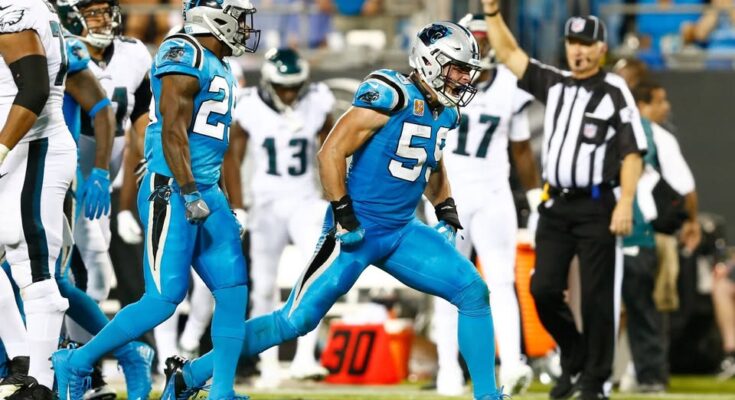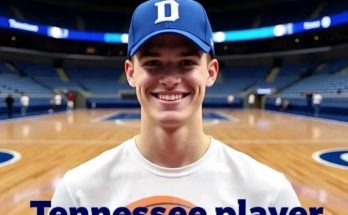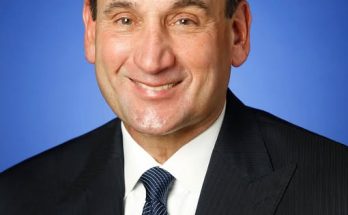For supporters of the Carolina Panthers, the past few seasons have been a grueling exercise in patience, marked by coaching changes, quarterback carousel woes, and a persistent struggle for wins. Hope, for many, has become a scarce commodity. So, when a rumor surfaces about the Panthers contemplating a “bold move” to acquire a defensive star, potentially costing $21 million, it’s understandable why it sparks a flicker of excitement, even if tempered by skepticism. The question on every long-suffering fan’s mind is: is a single defensive standout truly worth that kind of investment for a team currently in rebuilding mode?
The specific name being floated in connection with this $21 million acquisition is Trey Hendrickson, the star pass rusher from the Cincinnati Bengals. Reports from FOX Sports contributor David Helman suggest the Panthers are an “ideal landing spot” for Hendrickson, who led the NFL in sacks in 2024. This makes immediate sense from a positional need perspective; the Panthers have severely lacked a true star edge rusher since trading Brian Burns to the New York Giants.
Let’s break down the implications of such a move, weighing the potential benefits against the significant financial commitment and the broader context of the Panthers’ current situation.
A $21 million average annual value (AAV) contract for a defensive player immediately places them among the league’s highest earners at their position. For context, in 2025, players like Fred Warner (ILB, $21M AAV) and Kerby Joseph (S, $21.5M AAV) are in that range, while top-tier edge rushers like Myles Garrett ($40M AAV) and Danielle Hunter ($35.6M AAV) command significantly more. Hendrickson’s reported $21M AAV would place him squarely in the top echelon of defensive ends/edge rushers, though likely not at the very top.
As of early July 2025, the Carolina Panthers reportedly have around $17.2 to $23 million in available cap space. This is a manageable amount, especially considering the NFL’s projected salary cap increase for 2025 (between $277.5 million and $281.5 million). So, from a pure cap perspective, the Panthers could technically afford to absorb Hendrickson’s contract, particularly if they are structuring it with signing bonuses and back-loaded elements to manage the immediate cap hit. They also have some flexibility, as they can afford to wait on extending Bryce Young’s contract for a couple more seasons, given he’s still on his rookie deal.
However, affording it technically and affording it strategically are two different things. The Panthers have already invested heavily in their offensive line (Robert Hunt at $21.6M AAV, Taylor Moton at $31.3M cap hit in 2025, Damien Lewis at $14.57M AAV) and have star defensive tackle Derrick Brown on a substantial deal ($24M AAV). Adding another $21 million AAV contract for a defensive player would significantly tie up their long-term cap flexibility, especially as they look towards future extensions for key young players like Ikem Ekwonu and potentially Bryce Young.
Trey Hendrickson, who turned 30 in late 2024, has been a consistent force since joining the Bengals. Leading the league in sacks in 2024 (specific number not available in search results, but it’s mentioned as the league leader) is a monumental achievement and speaks to his elite ability to get to the quarterback. He’s a proven, high-motor player who would immediately become the premier pass-rushing threat the Panthers desperately need.
The Panthers’ defensive line was abysmal in 2024, finishing dead last in pressure generated without blitzing (23.2%). While they’ve invested in the defensive front in the 2025 offseason by acquiring Tershawn Wharton and drafting edge defenders Nic Scourton and Princely Umanmielen, adding a proven, top-tier veteran like Hendrickson would provide an immediate, tangible boost that young draft picks cannot guarantee. Derrick Brown’s return from injury (he missed most of 2024) will also be a massive plus, but he needs a complementary pass rusher to maximize his impact.
This is the crux of the debate for a struggling team.
- Immediate Game-Changing Impact: An elite pass rusher can fundamentally alter a defense. They create pressure, force turnovers, and can single-handedly swing momentum in games. This is something the Panthers have sorely missed. A player like Hendrickson could significantly improve their sack numbers and overall defensive efficiency.
- Elevates Others: An elite edge rusher draws double teams, which frees up other defensive linemen (like Derrick Brown) and linebackers to make plays. It also helps the secondary by forcing quarterbacks to get rid of the ball faster.
- Mentorship for Young Talent: Hendrickson’s presence would provide invaluable mentorship for young edge rushers like Scourton and Umanmielen, accelerating their development.
- Sends a Message: Acquiring a high-priced, proven star sends a clear signal to the locker room, the fanbase, and the rest of the league: the Panthers are serious about winning now. This can boost team morale and attract future free agents.
- Maximizing Bryce Young’s Rookie Deal Window: The Panthers are still paying Bryce Young a fraction of what he could be worth down the line. This “rookie QB window” is a critical period to build a competitive roster around him before his cap hit escalates. Investing in a game-wrecker now could be seen as maximizing this opportunity.
- Addressing a Core Weakness: Pass rush has been a persistent and glaring weakness for the Panthers. Acquiring Hendrickson directly addresses this critical deficiency with a top-tier solution.
- Age and Longevity: Hendrickson is 30. While elite, edge rushers relying on explosiveness can decline quickly in their early to mid-30s. A $21 million AAV contract often implies a multi-year commitment, and there’s a risk of diminished returns in the later years.
- Team Building Philosophy: A truly rebuilding team often prioritizes drafting young talent, developing them, and building through sustained, incremental improvements rather than making massive, singular investments. While Hendrickson fills a need, is it the most prudent use of significant capital for a team that isn’t a contender yet?
- Opportunity Cost: That $21 million could be allocated to multiple mid-tier free agents, addressing several smaller holes across the roster (e.g., in the secondary, which also lacks productivity and experience, or at linebacker, which looks weak). Spreading the wealth might create a more well-rounded team, even if it lacks a single “star.”
- Trade Capital: Acquiring Hendrickson would likely involve trading draft picks (though Helman notes the options for veteran trades are limited at this time of year as teams have invested cap space). For a rebuilding team, holding onto draft capital is often crucial for long-term roster construction.
- Contender Status: Helman himself notes, “Carolina doesn’t currently fit the mold of a contender that a 30-year-old All-Pro like Hendrickson would likely want to play for, but that’s the risk of asking for a trade.” Would Hendrickson truly elevate them to contention immediately, or would his impact be somewhat diluted by other roster deficiencies?
The rumor of the Carolina Panthers pursuing Trey Hendrickson for $21 million is a fascinating test of their team-building philosophy under General Manager Dan Morgan and Head Coach Dave Canales. From a pure need and immediate impact standpoint, Hendrickson is an undeniable fit. He would instantly become the best pass rusher the Panthers have had in years, and his presence could indeed elevate the entire defense. For fans starved of success, such a bold move offers genuine, tangible hope.
However, the financial commitment is significant, and for a team that has been struggling, it represents a substantial bet on a single player, potentially limiting flexibility down the line. If the Panthers believe they are just “a piece or two” away from genuine contention, then an aggressive move for an elite talent like Hendrickson makes sense. If they still view themselves as being in the earlier stages of a multi-year rebuild, then a more measured approach, prioritizing long-term cap health and spreading resources, might be more prudent.
Ultimately, the decision will come down to how the Panthers’ front office assesses their current roster, their timeline for contention, and the trade capital required. For now, the prospect of a true defensive game-changer in Carolina is enough to give beleaguered fans something to genuinely cheer about.



